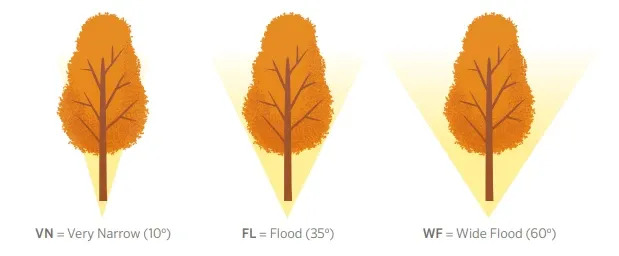The beam angle, also known as the beam spread, refers to the angle at which light emanates from a light source. Measured in degrees, it can range from very wide to very narrow. Specifically, the beam angle is defined as the greatest angle, measured from the center of the distribution, at which the light intensity drops to 50% of the maximum. Beam angles have a significant impact on the visual brightness of a lamp. For example, a 5-watt lamp with a very narrow beam angle will appear much brighter than a 20-watt lamp with a very wide beam spread when shining on the same surface from the same distance. Smaller angles result in tighter and more intense light beams, whereas wider angles disperse the light more diffusely over a larger area.
The light emitted from a source comprises the beam angle, the field angle, and the spill. The field angle represents the angle at which 90% of the light is found, while the area where the remaining 10% of light is found is known as the spill.
The beam angle plays a vital role in landscape lighting design.
- Narrow and very narrow beam angles (bullet or spotlights) are used for precise lighting on specific targets, such as reaching the tops of tall trees or illuminating a flagpole or statue. Tall, thin beams of light are ideal for grazing tall trees and highlighting architectural columns. These narrow beam angles allow for precise focus on designated areas, such as trees, statues, or water features.
- Medium-width beam angles are well-suited for general accent lighting, providing a broader spread of light that is perfect for illuminating larger areas like pathways or patio spaces. This type of beam angle produces a softer, more diffused lighting effect, adding a touch of elegance to the surroundings.
- Wider angle floodlights or wash lights are suitable for illuminating larger structures and broad trees and shrubs, driveways, patios, and parking lots. Ideal for wash lighting, these angles create a more even distribution of light and produce less of a hotspot compared to narrow beam lamps. They can also be installed high up on trees to create a moonlight-like effect on gardens, lawns, or patios.
The diameter of the beam angle increases as you move farther away from the light source. As light spreads out from the source, the intensity of illumination decreases. Achieving the desired lighting effect may require adjustments to the combination of fixtures and lamps used.
Beam Spreads & Applications
Beam angles are typically classified into six groups according to the America National Standard Institute (ANSI) standards:
- Narrow Spot (NS): 5-15°. These beams are small and focused, ideal for highlighting specific areas or creating dramatic thin beams of light on walls.
- Spot (ST): 16-22°. Spot beams strike a balance between narrow spots and narrow flood beams. They are suitable for illuminating small to medium-sized features, offering a tighter focus than narrow flood beams. Best for illuminating shrubs, pathways, and underwater features.
- Narrow Flood (NF): 23-32°. These beams are suitable for both highlighting and general area illumination. Perfect for lighting large steps, tall trees, driveways, and walkways.
- Flood (FL): 33-45°. Flood beams provide a wider spread of light without being too wide. Perfect for illuminating pathways, stairs, and trees.
- Wide Flood (WF): 46-74°. Wide flood beams cover larger areas or architectural features with a broad beam of light, providing less intense and more diffuse illumination. Ideal for illuminating walkways, tree canopies, entrances, signage, and gates.
- Very Wide Flood (VW): ≥ 75°. These beams create ultra-wide illumination, providing a large and uniform pool of light for wall-washing large facades and illuminating signage. They can also be pole-mounted for general area illumination.

Different beam angles play a crucial role in creating unique lighting effects when illuminating specific subjects. Some lighting products offer field adjustment capabilities with narrow, spot, flood, and wide flood lenses. By adjusting the beam angle, you can flexibly direct attention to specific areas in the landscape. Accurately determining the appropriate angle for the feature being illuminated is crucial to achieving the desired lighting effect.
The mounting height or distance from the luminaire to the feature being lit will significantly affect the effectiveness of the lighting. The beam angle determines the area being illuminated. For shorter distances, a wider flood beam is suitable. Conversely, when lighting a specific target at a greater distance, a more narrow and farther-reaching beam is preferred.
When using multiple fixtures, ensure that the distance between the light sources and the radium of the beams is considered to avoid overlapping illumination to ensure a well-coordinated and evenly distributed lighting effect.
To Sum up
Beam angles play a significant role in determining the number of lights needed for a space, ultimately impacting the overall lighting outcome. In various projects, it is common to employ a range of angles, especially in landscape lighting, as a one-size-fits-all approach is inadequate.
Different areas require diverse lighting solutions. For example, using a spot beam on a large tree creates a distinct effect compared to a wide beam on the same tree. The spot beam highlights only a small section of the trunk or leaves, while the wide beam showcases the entire tree in all its splendor. The broad and diffused light from the wide beam illuminates a much larger area than its narrower counterpart, revealing the tree’s natural beauty in its entirety.


